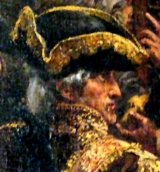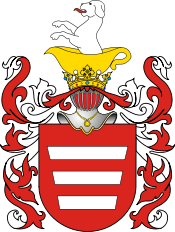
Franciszek Ksawery Branicki
Encyclopedia
Count Franciszek Ksawery Branicki (1730, Barwałd Górny - 1819) was a Polish
nobleman
of the Korczak
coat of arms, magnate
and one of the leaders of the Targowica Confederation
.
 Great Crown Podstoli
Great Crown Podstoli
in 1764, Ambassador in Berlin
in 1765, Master of the Hunt of the Crown in 1766-1773, Artillery General of Lithuania in 1768-1773, Ambassador in Moscow
in 1771, Field Crown Hetman in 1773 and Great Crown Hetman
of the Polish-Lithuanian Commonwealth
in 1774-1794.
Awarded with White Eagle Order in December 1764. He married Aleksandra von Engelhardt
, a niece of Prince Potemkin, in 1781.
Opponent of the reforms of the Great Sejm
(1788–1792), supporter of the Hetman Party and the Targowica Confederation
. Sentenced to death in absentia by the Supreme Criminal Court during the Kościuszko Uprising
(1794). He also fought a duel with the infamous Casanova, in which both were wounded but survived.
's 1891 painting, Constitution of May 3, 1791
.
Poland
Poland , officially the Republic of Poland , is a country in Central Europe bordered by Germany to the west; the Czech Republic and Slovakia to the south; Ukraine, Belarus and Lithuania to the east; and the Baltic Sea and Kaliningrad Oblast, a Russian exclave, to the north...
nobleman
Szlachta
The szlachta was a legally privileged noble class with origins in the Kingdom of Poland. It gained considerable institutional privileges during the 1333-1370 reign of Casimir the Great. In 1413, following a series of tentative personal unions between the Grand Duchy of Lithuania and the Kingdom of...
of the Korczak
Korczak
Korczak is a Polish noble family name. It may also refer to:* Korczak Coat of Arms* Janusz Korczak, a pseudonym of Henryk Goldszmit, Polish pediatrician, children's writer and pedagogist, murdered by the Germans at the Treblinka extermination camp...
coat of arms, magnate
Magnate
Magnate, from the Late Latin magnas, a great man, itself from Latin magnus 'great', designates a noble or other man in a high social position, by birth, wealth or other qualities...
and one of the leaders of the Targowica Confederation
Targowica Confederation
The Targowica Confederation was a confederation established by Polish and Lithuanian magnates on 27 April 1792, in Saint Petersburg, with the backing of the Russian Empress Catherine II. The confederation opposed the Polish Constitution of May 3, 1791, which had been adopted by the Great Sejm,...
.

Podstoli
Podstoli was a court office in Poland and Lithuania. A Podstoli was the deputy of a Stolnik, and was responsible for the King's pantry....
in 1764, Ambassador in Berlin
Berlin
Berlin is the capital city of Germany and is one of the 16 states of Germany. With a population of 3.45 million people, Berlin is Germany's largest city. It is the second most populous city proper and the seventh most populous urban area in the European Union...
in 1765, Master of the Hunt of the Crown in 1766-1773, Artillery General of Lithuania in 1768-1773, Ambassador in Moscow
Moscow
Moscow is the capital, the most populous city, and the most populous federal subject of Russia. The city is a major political, economic, cultural, scientific, religious, financial, educational, and transportation centre of Russia and the continent...
in 1771, Field Crown Hetman in 1773 and Great Crown Hetman
Hetman
Hetman was the title of the second-highest military commander in 15th- to 18th-century Poland and the Grand Duchy of Lithuania, which together, from 1569 to 1795, comprised the Polish-Lithuanian Commonwealth, or Rzeczpospolita....
of the Polish-Lithuanian Commonwealth
Polish-Lithuanian Commonwealth
The Polish–Lithuanian Commonwealth was a dualistic state of Poland and Lithuania ruled by a common monarch. It was the largest and one of the most populous countries of 16th- and 17th‑century Europe with some and a multi-ethnic population of 11 million at its peak in the early 17th century...
in 1774-1794.
Awarded with White Eagle Order in December 1764. He married Aleksandra von Engelhardt
Aleksandra von Engelhardt
Aleksandra von Engelhardt , also known as Sasjenka and Countess Branicka, was a Russian noble. She was the niece, confidant and likely the lover of Grigory Potyomkin, and the favourite and lady-in-waiting of Catherine the Great....
, a niece of Prince Potemkin, in 1781.
Opponent of the reforms of the Great Sejm
Great Sejm
The Great Sejm, also known as the Four-Year Sejm was a Sejm of the Polish-Lithuanian Commonwealth that was held in Warsaw, beginning in 1788...
(1788–1792), supporter of the Hetman Party and the Targowica Confederation
Targowica Confederation
The Targowica Confederation was a confederation established by Polish and Lithuanian magnates on 27 April 1792, in Saint Petersburg, with the backing of the Russian Empress Catherine II. The confederation opposed the Polish Constitution of May 3, 1791, which had been adopted by the Great Sejm,...
. Sentenced to death in absentia by the Supreme Criminal Court during the Kościuszko Uprising
Kosciuszko Uprising
The Kościuszko Uprising was an uprising against Imperial Russia and the Kingdom of Prussia led by Tadeusz Kościuszko in Poland, Belarus and Lithuania in 1794...
(1794). He also fought a duel with the infamous Casanova, in which both were wounded but survived.
Remembrance
He is one of the figures immortalized in Jan MatejkoJan Matejko
Jan Matejko was a Polish painter known for paintings of notable historical Polish political and military events. His most famous works include oil on canvas paintings like Battle of Grunwald, paintings of numerous other battles and court scenes, and a gallery of Polish kings...
's 1891 painting, Constitution of May 3, 1791
Constitution of May 3, 1791 (painting)
Constitution of May 3, 1791 is a late 19th century Romantic genre painting by the Polish artist Jan Matejko, commemorating the centenary of an important event in the history of Poland. It is an oil painting on canvas measuring 247 x 446 cm, and like many of Matejko's works, is a large and crowded...
.

